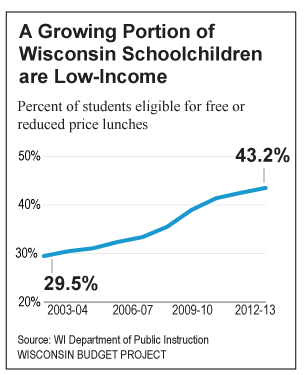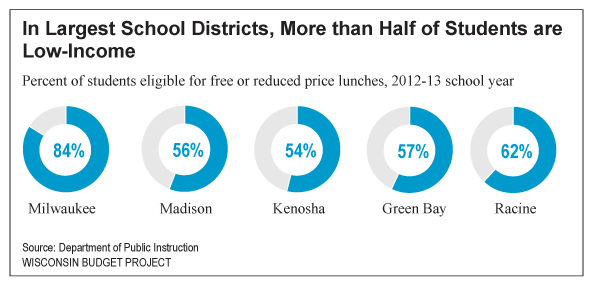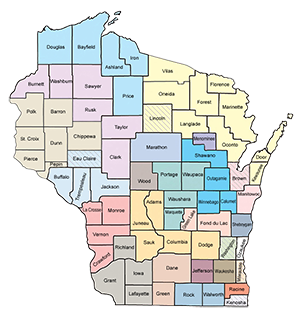by TAMARINE CORNELIUS
Original article
Tuesday, May 21, 2013
The number of Wisconsin children who are from low-income families has climbed for the ninth straight year, according to a new report from the state’s Department of Public Instruction.
In the 2012-13 school year, 42% of Wisconsin children were eligible for free or reduced-price school lunches. In the 2003-04 school year, just 30% of students qualified for free or reduced-price school lunches, as shown in the chart below. The share of students qualifying has climbed every year since then. This video shows how the share of low-income schoolchildren has changed over time in each school district.
 The criteria for qualifying for free or reduced-price lunches have stayed the same during the time period shown in the chart above. Students in families earning less than 130% of the federal poverty level qualify for free school lunches. For the 2013-12 school year, students from a family of four earning less than about $30,000 would qualify for free lunches. A much smaller number of students in families earning between 130% and 185% of the poverty level qualify for reduced-price lunches.
The criteria for qualifying for free or reduced-price lunches have stayed the same during the time period shown in the chart above. Students in families earning less than 130% of the federal poverty level qualify for free school lunches. For the 2013-12 school year, students from a family of four earning less than about $30,000 would qualify for free lunches. A much smaller number of students in families earning between 130% and 185% of the poverty level qualify for reduced-price lunches.
In Wisconsin’s largest school districts, more than half the students are from low-income families, as shown in the chart below. Eighty-four percent of the students in Milwaukee Public Schools are from low-income families.

The rising number of low-income students presents challenges for Wisconsin schools. Children from low-income families have poorer educational outcomes and lag their peers in educational achievement. They also are less likely to graduate from high school and become well-educated, healthy members of Wisconsin’s skilled workforce.
New policies proposed by state lawmakers may pose additional challenges to schools that serve largely low-income students. In his budget proposal, Governor Walker has recommended setting aside funding for schools that are rated the highest on DPI’s report card system. Schools that score in the lowest category would receive much less money, with the result that schools with relatively small numbers of students from low-income families would receive the most benefit. For more on that proposal, which is scheduled to be voted on by the legislature’s budget committee, read this blog post.
Tamarine Cornelius

